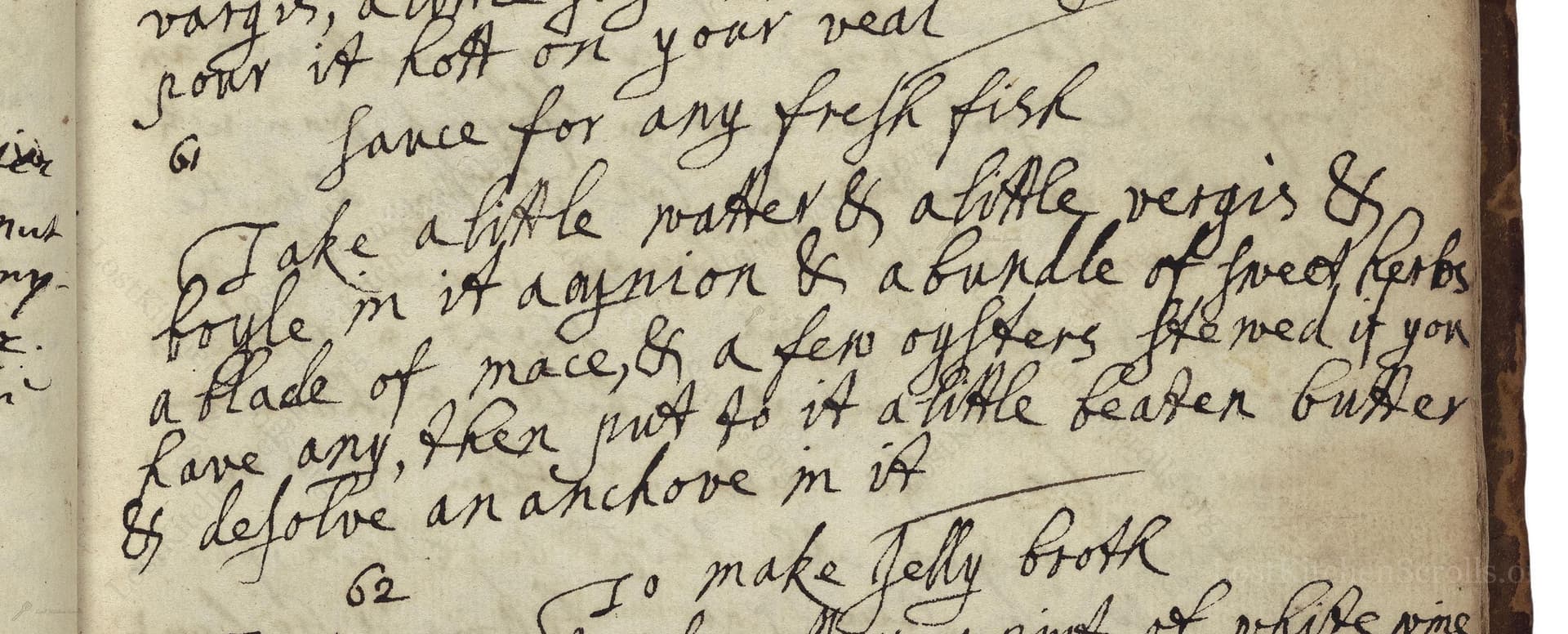Sauce For Any Fresh Fish
From the treasured pages of Receipt book of Penelope Jephson
Written by Penelope Patrick

Sauce For Any Fresh Fish
"Take a little water & a little pergies & boyle in it a oynion & a bundle of sweet herbs a blade of mace, & a few oysters stewed if you have any, then put to it a little beaten butterr & dessolve an anchove in it."
Note on the Original Text
The recipe employs the concise and direct prose characteristic of manuscript cookery of the era, using imperative verbs and presuming the cook's familiarity with procedure. 'Perries' likely refers to small fish—possibly a regional term or variant spelling. Spelling was not standardized, so words like 'oynion' (onion), 'pergies', and 'boyle' (boil) reflect 17th-century English conventions. Quantities are vague, trusting the cook's judgment, as measurements were rarely specified in home recipes at the time.

Title
Receipt book of Penelope Jephson (1673)
You can also click the book image above to peruse the original tome
Writer
Penelope Patrick
Era
1673
Publisher
Unknown
Background
Step back into the sumptuous kitchens of the late 17th century with Penelope Patrick’s culinary collection—a feast of historic recipes, secret tips, and the irresistible flavors of Restoration England all bound together in a handwritten treasure.
Kindly made available by
Folger Shakespeare Library
Penned between 1671 and 1675 by Penelope Patrick, this sauce recipe hails from Restoration-era England. This period followed the English Civil War and was marked by the return of the monarchy and a lively culinary exchange between England and continental Europe. Household manuscripts from women like Penelope Patrick shed light on the everyday cooking practices and flavor preferences of the English gentry. Sauces like this one were prized for transforming simple boiled fish into a savory, aromatic dish enriched with the umami of shellfish and anchovies—a technique borrowed from French cuisine.

In the late 17th century, this sauce would have been prepared over an open hearth or a wood-fired range, using an iron or copper saucepan. A mortar and pestle might have been employed to crush herbs or spices, while long-handled wooden spoons or spatulas would be used to stir and emulsify the butter. Simple cloths or strainers filtered the sauce, ensuring smoothness before service.
Prep Time
10 mins
Cook Time
10 mins
Servings
2
We've done our best to adapt this historical recipe for modern kitchens, but some details may still need refinement. We warmly welcome feedback from fellow cooks and culinary historians — your insights support the entire community!
Ingredients
- 7 fl oz water
- 0.7 oz small salted fish (substitute: whitebait or anchovies)
- 1 medium onion (about 3.5 oz), sliced
- 0.2 oz fresh sweet herbs (parsley, thyme, bay leaf)
- 1 blade mace (or small pinch ground mace)
- 1 oz oysters, stewed or lightly poached (optional)
- 1.75 oz unsalted butter
- 0.35 oz anchovy fillet
Instructions
- To prepare this classic sauce for any fresh fish, start by adding about 7 fl oz of water and approximately 0.7 oz of small salted fish—use whitebait or even anchovies as a stand-in for "pergies"—to a saucepan.
- Slice a medium onion and add it, along with a small bundle (about 0.2 oz) of fresh sweet herbs such as parsley, thyme, and a bay leaf.
- Toss in a blade of mace (or a pinch if ground).
- If available, include 1 oz of oysters—stewed or lightly poached.
- Simmer gently for about 10 minutes.
- Remove the herbs and aromatics, then whisk in 1.75 oz of softened butter until it melts and thickens.
- Dissolve one fillet (about 0.35 oz) of anchovy into the hot sauce.
- Pour over your cooked fish and serve immediately.
Estimated Calories
200 per serving
Cooking Estimates
It takes about 10 minutes to simmer the sauce ingredients, and around 10 minutes to prepare and measure everything. This recipe makes enough sauce for about 2 servings. Each serving is estimated to have around 200 calories.
As noted above, we have made our best effort to translate and adapt this historical recipe for modern kitchens, taking into account ingredients nowadays, cooking techniques, measurements, and so on. However, historical recipes often contain assumptions that require interpretation.
We'd love for anyone to help improve these adaptations. Community contributions are highly welcome. If you have suggestions, corrections, or cooking tips based on your experience with this recipe, please share them below.
Join the Discussion
Rate This Recipe
Dietary Preference
Main Ingredients
Occasions

Den Bockfisch In Einer Fleisch Suppen Zu Kochen
This recipe hails from a German manuscript cookbook compiled in 1696, a time whe...

Die Grieß Nudlen Zumachen
This recipe comes from a rather mysterious manuscript cookbook, penned anonymous...

Ein Boudain
This recipe comes from an anonymous German-language manuscript cookbook from 169...

Ein Gesaltzen Citroni
This recipe, dating from 1696, comes from an extensive anonymous German cookbook...
Browse our complete collection of time-honored recipes



